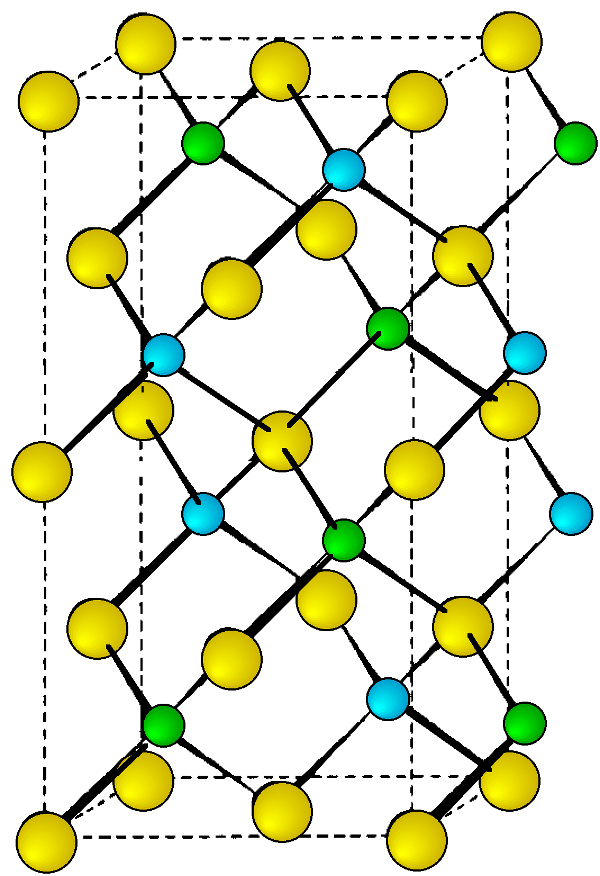| << Chapter < Page | Chapter >> Page > |
| Compound | Structure | Lattice parameter (Å) | Density (g/cm 3 ) |
| ZnS | zinc blende | a = 5.410 | 4.075 |
| wurtzite | a = 3.822, c = 6.260 | 4.087 | |
| ZnSe | Zinc blende | a = 5.668 | 5.27 |
| ZnTe | Zinc blende | a = 6.10 | 5.636 |
| CdS | wurtzite | a = 4.136, c = 6.714 | 4.82 |
| CdSe | wurtzite | a = 4.300, c = 7.011 | 5.81 |
| CdTe | Zinc blende | a = 6.482 | 5.87 |
| HgS | cinnabar | a = 4.149, c = 9.495 | |
| Zinc blende | a = 5.851 | 7.73 | |
| HgSe | Zinc blende | a = 6.085 | 8.25 |
| HgTe | Zinc blende | a = 6.46 | 8.07 |
The zinc chalcogenides all transform to a cesium chloride structure under high pressures, while the cadmium compounds all form rock salt high-pressure phases ( [link] ). Mercury selenide (HgSe) and mercury telluride (HgTe) convert to the mercury sulfide archetype structure, cinnabar, at high pressure.

Nearly all I-III-VI 2 compounds at room temperature adopt the chalcopyrite structure ( [link] ). The cell constants and densities are given in [link] . Although there are few reports of high temperature or high-pressure phases, AgInS 2 has been shown to exist as a high temperature orthorhombic polymorph ( a = 6.954, b = 8.264, and c = 6.683 Å), and AgInTe 2 forms a cubic phase at high pressures.

| Compound | Lattice parameter a (Å) | Lattice parameter c (Å) | Density (g.cm 3 ) |
| CuAlS 2 | 5.32 | 10.430 | 3.45 |
| CuAlSe 2 | 5.61 | 10.92 | 4.69 |
| CuAlTe 2 | 5.96 | 11.77 | 5.47 |
| CuGaS 2 | 5.35 | 10.46 | 4.38 |
| CuGaSe 2 | 5.61 | 11.00 | 5.57 |
| CuGaTe 2 | 6.00 | 11.93 | 5.95 |
| CuInS 2 | 5.52 | 11.08 | 4.74 |
| CuInSe 2 | 5.78 | 11.55 | 5.77 |
| CuInTe 2 | 6.17 | 12.34 | 6.10 |
| AgAlS 2 | 6.30 | 11.84 | 6.15 |
| AgGaS 2 | 5.75 | 10.29 | 4.70 |
| AgGaSe 2 | 5.98 | 10.88 | 5.70 |
| AgGaTe 2 | 6.29 | 11.95 | 6.08 |
| AgInS 2 | 5.82 | 11.17 | 4.97 |
| AgInSe 2 | 6.095 | 11.69 | 5.82 |
| AgInTe 2 | 6.43 | 12.59 | 6.96 |
Of the I-III-VI 2 compounds, the copper indium chalcogenides (CuInE 2 ) are certainly the most studied for their application in solar cells. One of the advantages of the copper indium chalcogenide compounds is the formation of solid solutions (alloys) of the formula CuInE 2-x E' x , where the composition variable (x) varies from 0 to 2. The CuInS 2-x Se x and CuInSe 2-x Te x systems have also been examined, as has the CuGa y In 1-y S 2-x Se x quaternary system. As would be expected from a consideration of the relative ionic radii of the chalcogenides the lattice parameters of the CuInS 2-x Se x alloy should increase with increased selenium content. Vergard's law requires the lattice constant for a linear solution of two semiconductors to vary linearly with composition (e.g., as is observed for Al x Ga 1-x As), however, the variation of the tetragonal lattice constants ( a and c ) with composition for CuInS 2-x S x are best described by the parabolic relationships.
a = 5.532 + 0.0801 x + 0.0260 x 2
c = 11.156 + 0.1204 x + 0.0611 x 2
A similar relationship is observed for the CuInSe 2-x Te x alloys.

Notification Switch
Would you like to follow the 'Physical methods in chemistry and nano science' conversation and receive update notifications?